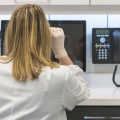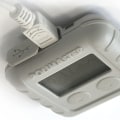Film badges are the most commonly used dosimeter for radiation protection. They are used to measure gamma rays, x-rays, and high-energy beta radiation. The second most sensitive dosimeter is the optically stimulated luminescence dosimeter (OSL dosimeter). This type of dosimeter is lightweight, durable, and easy to carry.
It contains an aluminum oxide detector and is read with a laser light at selected frequencies. When laser light hits the sensor material, it becomes luminescent in proportion to the amount of radiation exposure it received. An OSL dosimeter can be used for up to a year, but it's usually only used 1 to 3 months before reading it. These devices provide an accurate reading of as low as 10 µSv for X-ray and gamma ray photons with energies ranging from 5 keV to more than 40 MeV.
Radiation workers often use an electronic personal dosimeter (EPD), which is worn on the torso and displays the immediate dose and dose rate on the small monitor. Electronic personal dosimeters use a metal oxide semiconductor field-effect transistor (MOSFET or MOS transistor) that triggers an alarm when radiation levels exceed regulatory compliance. A person uses a personal dosimeter for a specific period of time. The dosimeter is usually sent to a center that examines the radiation dose, but it can also be read at the site of a hot zone.
A TLD dosimeter badge is one of the most common types of TLD dosimeters used by professionals. This type of TLD dosimeter is mainly used to monitor beta and gamma radiation emitted by x-ray machines. The most commonly used personal neutron dosimeters for radiation protection purposes are thermoluminescent dosimeters and albedo dosimeters. Both are based on thermoluminescence, with lithium fluoride (LiF) being widely used as a sensitive material (chip).
Lithium has two stable isotopes, lithium-6 (7.4%) and lithium-7 (92.6%). Li-6 is the neutron-sensitive isotope. LiF crystal dosimeters can be enriched in lithium-6 to improve the nuclear reaction of lithium-6 (n, alpha) to record neutrons. Small LiF crystals are the most common TLD dosimeters, as they have the same absorption properties as soft tissues.
Detector efficiency depends on neutron energy, making it difficult to make a dosimeter independent of neutron energy. LiF dosimeters are mainly used, which contain different percentages of lithium-6 to separate neutrons and thermal photons. LiF chip enriched in lithium-6 is very sensitive to thermal neutrons, while LiF chip containing very little lithium-6 has a negligible neutron response. A radiation dosimeter is a device that measures the dose absorption of external ionizing radiation.
It is used by the person being monitored when using it as a personal dosimeter and is a record of the radiation dose received. Modern electronic personal dosimeters can provide a continuous reading of the cumulative dose and the current dose rate, and can warn the user with an audible alarm when a specified dose rate or cumulative dose is exceeded. Other dosimeters, such as thermoluminescent or film types, require post-use processing to reveal the cumulative dose received and cannot give a current dose indication while in use. One of the most common tools used to monitor and calculate this level of radiation that people are exposed to in the workplace is a dosimeter.
The two most common types of thermoluminescent materials used for dosimetry are calcium fluoride and lithium fluoride, with one or more impurities (e.g.). The electronic personal dosimeter is the most commonly used type and has a number of sophisticated functions, such as continuous monitoring, which allows alarm warnings at preset levels and live reading of the accumulated dose. Dosimeters are most commonly used by professionals in industrial and medical sectors, as well as emergency radiation workers like first responders and hazardous materials professionals.


